Imagine stepping into an artist’s studio, where a blank canvas lies ready for a masterpiece. Your garden is that canvas! But like any good artist, the tools you choose can make or break your work of art. Two of the most indispensable tools in our gardening arsenal are geotextile and landscape fabric.
I promise you this: by sketching out these two horticultural titans – their ins and outs, pros and cons – we’ll unearth their hidden talents together. And much like choosing between oil paints or watercolors, finding your perfect match all depends on what kind of masterpiece you aspire to create.
So don’t go picking up your paintbrush just yet! Let us guide you through these essential materials that might just transform your garden from ordinary to extraordinary. Buckle up as we dig deeper into the world of geotextiles vs landscape fabrics – trust me; it’s going to be quite an expedition!

Material Composition of Geotextiles
Geotextiles are synthetic fabrics made from materials such as polypropylene, polyester, or nylon. They have a porous structure that allows water and air to pass through while retaining soil particles.
Geotextiles are typically needle-punched or woven, providing strength and durability for various applications.
Functional Differences between Geotextiles and Landscape Fabrics
While both geotextiles and landscape fabrics serve similar purposes in gardening projects, there are some functional differences between the two.
Geotextiles are primarily used for soil stabilization in areas prone to erosion or where heavy machinery may be present. They provide reinforcement by distributing the load across a wider area, preventing sinkage and maintaining structural integrity.
On the other hand, landscape fabrics focus more on weed control while allowing water to permeate through. They create a barrier that prevents weeds from growing while still providing drainage capabilities.
Permeability and Drainage Capabilities Comparison
When it comes to permeability and drainage capabilities, geotextiles outperform landscape fabrics. The porous nature of geotextiles allows water to penetrate freely into the soil below while simultaneously retaining soil particles.
Landscape fabrics, although also designed with permeability in mind, may have a higher chance of clogging over time due to organic matter accumulation or excessive rainfall events. This can hinder proper drainage if not regularly maintained.
Effectiveness in Weed Control: Geotextile vs Landscape Fabric
Using either material can significantly reduce weed growth compared to not using any fabric at all; However, some studies suggest that using landscape fabric is more effective in preventing weed growth than geotextile.
This may be due to the tighter weave or higher density of certain landscape fabrics that provide a stronger barrier against weeds.
However, it’s important to note that neither geotextiles nor landscape fabrics are foolproof when it comes to weed control. Determined and resilient weeds can still find their way through gaps or tears in the material. Regular inspections and maintenance are necessary for optimal results.
Durability, Lifespan, and Maintenance: Comparative Analysis

When it comes to durability and lifespan, geotextiles generally have an edge over landscape fabrics.
Due to their synthetic composition and construction techniques, geotextiles are designed to withstand harsh environmental conditions such as heavy rainfall or exposure to UV radiation without degrading quickly.
Landscape fabrics, on the other hand, may deteriorate over time due to continuous exposure to UV rays from the sun. They may also be prone to tearing if mishandled or subjected to excessive wear and tear during installation processes.
Both materials require some level of maintenance throughout their lifespan. This includes regular inspection for any signs of damage or deterioration, as well as removing any accumulated debris that could potentially clog the permeable surface.
Impact on Soil Health and Plant Growth
The impact on soil health and plant growth depends largely on how each material is used in gardening projects.
Geotextile Geotechnical engineers often recommend using geotextiles near eroding slopes or areas with heavy foot traffic because these materials can help stabilize soils without impeding water penetration.
Their permeable nature allows roots access into deeper layers while retaining essential nutrients within reach of plants’ root systems.
However on the downside, geotextiles do not break down over time, so they must be removed if gardeners want sustainable gardens like vegetable plots which need regular soil amendment. Additionally, the synthetic nature of geotextiles may not be ideal for organic gardening practices.
On the other hand, landscape fabrics pose minimal risks to soil health when used correctly. They can provide an effective barrier against weeds while still allowing water and nutrients to reach plant roots.
Comparison of Cost-effectiveness and Environmental Friendliness

Cost-effectiveness is an important consideration for any gardening project. Geotextiles tend to be more expensive upfront due to their superior durability and specialized applications such as erosion control or road construction.
Landscape fabrics, being more readily available and commonly used in residential gardening projects, are generally more cost-effective in terms of initial purchase cost.
When it comes to environmental friendliness, both materials have pros and cons. Geotextiles are typically made from non-biodegradable materials that can contribute to waste accumulation in landfills after their useful lifespan ends.
However, they do offer benefits such as reduced need for chemical weed control or repeated maintenance efforts over time.
Landscape fabrics often consist of biodegradable materials or recyclable plastics designed with Earth-friendly initiatives in mind. These options are especially suitable for gardeners who prioritize sustainability and eco-friendliness in their landscaping choices.
Types, Varieties Available for Commercial Use
Both geotextiles and landscape fabrics come in various types depending on specific project requirements:
1) Geotextile Varieties:
- Non-woven geotextiles: Made by entangling fibers together through mechanical processes.
- Woven geotextiles: Constructed by weaving individual threads to create a sturdy fabric structure.
2) Landscape Fabric Varieties:
- Light-duty landscape fabrics: Suited for weed control in garden beds or areas with minimal foot traffic.
- Heavy-duty landscape fabrics: Designed for larger projects, such as preventing weed growth under gravel driveways or walkways.
In Conclusion
Choosing between geotextiles and landscape fabrics boils down to your specific gardening goals and project requirements. While geotextiles excel in soil stabilization and erosion control, landscape fabrics shine in weed prevention and water permeability.
Consider the longevity, environmental impact, and cost-effectiveness of each material before making your decision. Whether you’re crafting an intricately designed garden oasis or fortifying outdoor structures against erosion, these versatile materials have the potential to elevate your gardening endeavors and contribute to the lasting beauty of your landscape masterpiece.
So, as you embark on your gardening journey, remember that the canvas may be blank, but with the right tools, you can paint a picture of natural splendor that will flourish for years to come.


